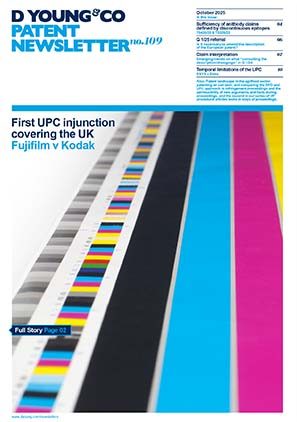The “patented” Nike Vaporfly - a step too far?
The Nike Vaporfly running shoe (variants of which recently allowed Brigid Kosgei to run the Chicago Marathon in world record time and Eliud Kipchoge to run the world’s first sub two-hour marathon) have proved hugely controversial. Critics claim the technology in the shoes provides an unfair advantage to athletes. Concerns have been so high that World Athletics recently issued tighter regulations on the shoes usable in competition. Adding fuel to the fire are the media reports stating the shoes are “patented” so shoe makers other than Nike cannot use the technology in the shoes and athletes sponsored by companies other than Nike are therefore at a disadvantage. Should Nike’s competitors be worried? And what should Nike (and their competitors) be thinking about when considering patent protection?
Patent applications or granted patents?
Firstly, it is important to remember that, although many patent applications may be filed by a company, only granted patents are enforceable against a third party.
In most major jurisdictions, a patent application only becomes a granted patent if it satisfies the requirements of the technology it describes being novel (new) and inventive over what was publicly known before (the “prior art”, for example,. previously published documents or products already on the market). The journey from patent application to granted patent can take several years of examination by the relevant patent office and, often, an initially broad scope of protection sought in the original patent application (defined by the patent “claims”) must be significantly narrowed to meet the requirements of novelty and inventive step. An initially broad, threatening patent application may therefore eventually protect a much smaller aspect of a product than initially envisaged when it actually grants. If sufficiently relevant prior art exists, it may not even be granted at all.
Before thinking about asserting patent rights against a third party or worrying about patent rights held by a third party, it is therefore important to distinguish between granted patents and patent applications and, in the case of patent applications, to undertake a reasoned analysis of whether the patent application is likely to grant and, if so, what the granted scope of protection might be and whether this will be useful or problematic to you. There are even mechanisms (such as the opposition procedure of the European Patent Office) to revoke granted patents which shouldn’t have been granted (for example, if you know of some novelty destroying prior art which the patent office missed).
Reviewing the validity and/or infringement of patent rights is complex and it is therefore highly recommend to consult a patent attorney to help you.
The impact of regulations
Secondly, the regulations brought in by governing bodies (such as World Athletics) can have a significant impact on which technology might be valuable to patent.
For example, the new World Athletics regulations state that the shoe sole must be no thicker than 40mm and that, other than shoes with spikes (which are allowed an additional plate for attaching the spikes), the shoe must contain only one rigid embedded plate or blade. These regulations seem specifically targeted at the Nike Vaporfly range, which include both a very thick foam sole and a carbon fibre blade.
Thus, although it might be possible to patent novel and inventive shoes which happen to have soles thicker than 40mm and multiple carbon fibre blades, the value of such patents might be limited, given that neither your own sponsored athlete nor their competitors will be allowed to use such shoes in competition. It would seem more prudent to focus your patenting efforts on protecting novel and inventive features which improve the performance of single-bladed, thinner soled shoes which meet the World Athletics regulations. Such granted patents might be very valuable indeed in staying ahead of the competition.
Timing
Thirdly, it is important to think about timing. One of the new World Athletics regulations is that any shoe used in competition must have been available for purchase on the open retail market four months beforehand. This creates an incentive for shoe makers to release the shoes their sponsored athlete is to wear in competition on the open market as soon as possible to ensure compliance with this deadline. However, given that the selling of the shoes will be prior art to any later filed patent application covering technology included in the shoes, it is important that company patent departments and their outside counsel are kept up-to-date with the release date of the shoes so they can ensure any relevant patent applications are filed before this date.
This third point leads on to an interesting potential “squeeze” argument for use by the competitor of a patent holder (for example, in opposition proceedings at the European Patent Office).
If it does turn out that a patent holder seems to have filed a patent application too late (for example, after some of the shoes concerned had already been sold), they may argue that the shoes were, in fact, first put on sale to the public at a later date after the relevant patent application had been filed (for example, by arguing that the initial, earlier sale before the patent filing date was to a limited set of buyers and was therefore not “public”).
However, assuming that “public” and “open retail market” amount to the same thing, if this later date turns out to be less than four months prior to the use of the shoe in competition, this would mean a breaking of the World Athletics regulations. The patent holder is therefore put in the awkward position of either (a) losing their patent protection or (b) admitting breaking the World Athletics regulations (presumably leading to disqualification of their sponsored athlete)!
These examples thus demonstrate just some of the things which need to be considered in using IP to keep ahead of the pack in one of the most competitive of human endeavours.


